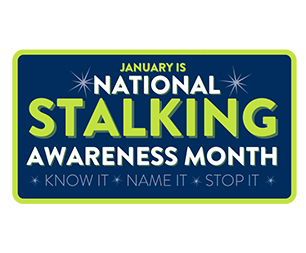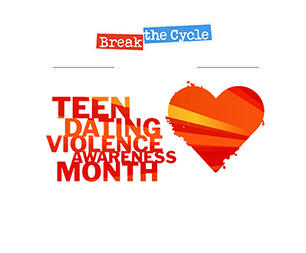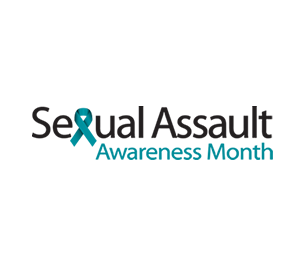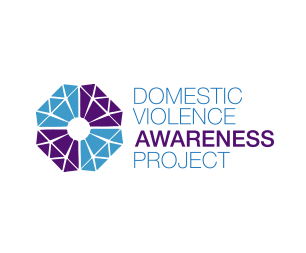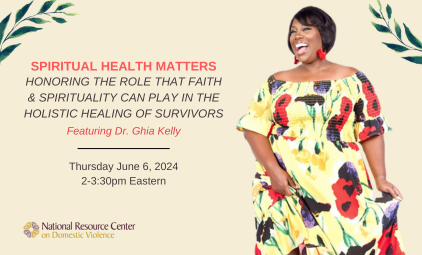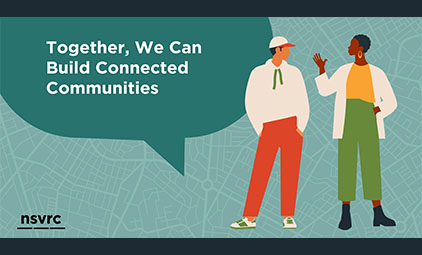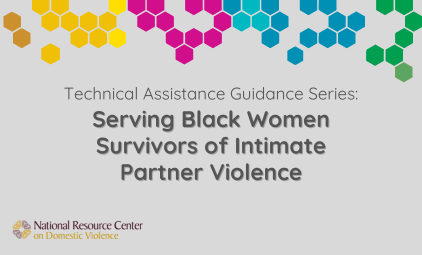By Julia Saladino, Senior Staff Attorney with WomensLaw and Patty Branco, Senior Technical Assistance Specialist with the National Resource Center on Domestic Violence
Protective orders are a commonly used legal avenue for survivors of domestic violence to get protection from an abuser. Protective orders may be called restraining orders, protection orders, injunctions, or by a different name depending on the state. They are a civil court order that allows a judge to order an abuser to stop abusing or harassing or face serious legal consequences. One benefit of the protective order process to survivors is that in most states, survivors have the option to file for an order on their own, without involving a lawyer or the police, which is how the process was designed since protective orders are often needed for immediate safety. However, advocates at domestic violence programs can be very helpful in supporting survivors throughout this process. Similarly, consulting with a lawyer while preparing for a protective order hearing can be invaluable as lawyers can help explain the specific court process in the survivor’s state and provide legal advice.
Types of Orders
Each state/territory and the District of Columbia has a protective order available to survivors of domestic violence. The legal definition of domestic violence may include incidents of physical abuse, threats to commit bodily harm, stalking, sexual assault, and destruction of property. It is important to note that the definition of domestic violence varies slightly in each state. Additionally, to qualify for a domestic violence protective order, the survivor must also have some type of specific relationship with the abuser; usually the abuser must be a family or household member. This generally includes current and former spouses, relationship partners, and family members.
Many states also have protective orders for other types of abuse that often do not require that the survivor have any specific type of relationship with the abuser. For example, in many states a survivor of stalking or sexual assault may be able to get a protective order against the abuser even if the abuser is not known to the victim. To get one of these orders, the survivor may need adequate identifying information to file the case, such as the abuser’s name and an address where the police could serve court paperwork. However, the survivor would not have to prove any type of relationship with the abuser to qualify for a protective order.
Additionally, protective orders are usually available on an emergency basis before a final order is issued. Generally, a survivor can get an emergency protective order on the same day that they file. Emergency orders are issued “ex parte,” which means that the abuser does not need to have notice of the case or an opportunity to participate in the hearing. If a judge issues an emergency order, these usually last for a short period of time (2-3 weeks, depending on the state). During this time period, the survivor is responsible for arranging for the abuser to be served with court paperwork through a third party. Service of process is the procedure where a party to a lawsuit gives an appropriate notice of the action to the other person. However, the survivor should not attempt to serve the abuser themselves. Then the abuser is given an opportunity to participate in a hearing and present testimony and evidence to the judge. After this opportunity, the judge may issue a final protective order that lasts for a longer period of time, generally around a year in most states, often with the option to renew the order once it expires. Note that permanent protective orders are extremely rare. Consequences for violation of a protective order vary from state to state but they may include criminal prosecution and imprisonment or fine (or a combination of both).
How to Get a Protective Order
“Staff was with me at the courthouse when requesting the restraining order and helped me filling out and filing papers for my child’s custody.” – DV Survivor
To start the protective order process, a survivor can go to the local courthouse to file a petition. A survivor can usually file in the county where they live, the county where the abuser lives, or the county where the abuse occurred. The survivor will have to describe the most recent incidents of abuse and include details about when and where the incidents took place. There may be an advocate or a volunteer attorney at the courthouse that can help with filling out a petition. Because going to the courthouse may feel very intimidating for survivors, advocates can be helpful in providing accompaniment and emotional support. The survivor may need to attest to the truthfulness of the petition under oath before signing and filing it. If the survivor has requested an emergency order, then usually they will see a judge that same day. The judge may ask some questions about the abuse to decide whether to issue an emergency order.
In most states, the survivor will also get a court date to return for a hearing for a long-term order. At this hearing, the survivor may need to show the judge evidence of the most recent abuse and testify about the incidents, as well as convince the judge that they fear bodily injury or harm and explain why they need the protective order for their safety. In most states, judges decide whether or not to issue a long-term protective order based on the “preponderance of the evidence,” meaning that the judge is “more certain than not” that abuse has occurred. This is different from criminal cases, where the standard of proof is typically “beyond a reasonable doubt.” This is good news for survivors seeking protective orders, as it means that far less evidence is required in order to meet the burden of proof for a protective order. Evidence can include personal testimony, photos of injuries, examples of harassing text messages or voicemails from the abuser, etc.
How Protective Orders Can Support Survivors’ Safety
“Protective orders can be an extremely valuable tool for enhancing survivors’ safety, but it’s important to remember that they are just one component of a comprehensive, personalized safety plan." – Former DV Court Advocate
Once a survivor obtains a protective order, it is important that they know the ways in which it does and does not keep them safe from further abuse. Because this is a civil legal remedy, not a criminal one, having a protective order does not generally mean that an abuser has been found guilty of any wrongdoing or will do any time in jail. Typically, protective orders set rules around how and when the abuser is or is not allowed to contact or be near the survivor (for example, it may stipulate that they may not contact the survivor in any way and must remain at least 500 feet away for the period of one year). Violating the terms of a protective order is a crime, so the order is generally enforced by contacting the police. Some jurisdictions may also offer the option for survivors to file a “motion for contempt” when their protective order has been violated, meaning that the abuser will have to reappear in court and can face jailtime, fines, and/or court-mandated batterer intervention.
Womenslaw.org offers a series of video blogs about protective orders, which are narrated in Spanish with English subtitles. They include information on what protective orders are, who qualifies for an order, what to expect during the court process, the evidence that could be useful in court, and how protective orders can help survivors of abuse.
Pt. 2- Who can get a protection order? from Julia Saladino on Vimeo.
Although a lawyer is not required, consulting with one while preparing for a protective order hearing can be extremely helpful. Lawyers can help explain the specific court process in the survivor’s state and provide legal advice. Survivors can access Womenslaw.org to search for information about free or low-cost legal services in every state. Advocates may also be able to help survivors prepare for court, safety plan, and feel emotionally supported during the court process. The following section offers some considerations for advocates as they work with survivors to learn about and obtain protective orders.
Additional Considerations
“(…) there was one person who was part of the like, domestic violence advocate program, who like actually helped me walk through the paperwork steps and that was really helpful because that was just like so overwhelming and so much bureaucracy and so much baloney to deal with. So it was definitely helpful to have people who specifically had answers or methods or, but then also just like, any kind of emotional support I found helpful.” – DV Survivor
Community-Specific Barriers:
Navigating the protective order process can be difficult and triggering for trauma survivors. The process can be particularly daunting for survivors living at the intersection of multiple forms of oppression. For instance, Black women may be reluctant to trust and utilize the legal system due to perceived or actual police inaction, hostility and bias against communities of color (National Domestic Violence Hotline, 2015; ACLU, 2015). The paperwork to request a protective order can present an obstacle for an immigrant survivor with limited English proficiency, or navigating the courthouse can present challenges for a survivor with a physical disability. The Battered Women’s Justice Project (BWJP) offers updated tools, training and technical assistance to equip advocates to best support survivors’ needs as it relates to protective orders. For example, BWJP’s tip sheet, Protection Orders and Working with People with Disabilities, is designed to assist advocates and practitioners in foreseeing, recognizing, and eliminating barriers to justice in the protective order process for people with disabilities. Keep in mind that while protective orders have been found to be a low-cost, effective solution in either stopping or significantly reducing domestic violence, there are greater obstacles to enforcement in rural areas (Logan & Walker, 2011). It’s important that policies and services are tailored to address community-specific barriers and differences such as hours of access, time it takes to obtain or serve an order, and access to information about the process.
Firearms:
Research suggests that the potential protective effects of protective orders may be enhanced by laws that prohibit respondents from purchasing and possessing firearms. BWJP’s National Center on Protection Orders and Full Faith & Credit (NCPOFFC) provides training and technical assistance on the firearm prohibitions related to domestic violence to improve the safety of victims and responses from law enforcement and courts. This checklist provides information for advocates facilitating a discussion with survivors about firearms. It also provides key information on provisions prohibiting the purchase or possession of firearms by those subject to a protective order or those convicted of a misdemeanor crime of domestic violence.
Children:
Shared parenting responsibilities complicate the protective order process. Although protective orders generally stipulate that the respondent may not communicate with the victim in any way, this is not always a viable option for parents who may need to coordinate custody and other child-rearing responsibilities. Often, the court will try to work with parents to develop a “parenting plan” in order to honor the custody rights of each parent while keeping everyone as safe as possible. Advocates can play a key role in helping survivors to strategize about ways to handle custody exchanges and other co-parenting concerns while maintaining their own safety and the safety of their children.
Pets:
Greater visibility and acceptance of the connection between animal abuse and domestic violence has led to an increased push for the inclusion of pets on domestic violence protection orders. The Animal Welfare Institute (AWI) produces and publishes state manuals designed to enable lawyers and advocates to further assist domestic violence survivors by getting their companion animals included on protection orders.
Conclusion
Protective orders are an invaluable tool that survivors can utilize to obtain safety. However, protective orders fail to ensure safety if they are not enforced. Police and court enforcement of protective orders is imperative because it shows abusers that there are serious legal consequences for violating an order. Inconsistent enforcement can increase danger by creating a false sense of security for survivors, who may actually refrain from seeking justice system intervention if abusers violate orders with impunity. That said, protective orders are only effective as a safety strategy if systems are invested in and committed to holding abusers accountable.
A significant barrier to the enforcement of protective orders is the lack of coordination, communication and understanding amongst systems and professionals involved in the process (that is, advocates, attorneys, law enforcement, and court personnel). For example, Native American survivors are at great danger if prosecutors, court staff, judges, and law enforcement lacks understanding of enforcement of tribal protective orders across jurisdictional lines. In addition to supporting individual survivors in learning about and applying for protective orders, advocates are thus well positioned to build relationships with law enforcement agencies to assist police in receiving adequate training and developing enforcement protocols. Another key role played by advocates in this process is to advocate for legislation that will improve outcomes for survivors. For example, advocates pushed for the Full Faith and Credit (FFC) provision of the Violence Against Women Act (VAWA), which mandates that courts and law enforcement recognize and enforce protection orders from other U.S. jurisdictions as if they were issued in their jurisdiction.
As we consider the importance of protective orders enforcement, we need to keep in mind as well that some survivors do not trust law enforcement agencies to protect them, citing police inaction, hostility, and bias against marginalized groups as key barriers to seeking assistance from law enforcement or the court system (National Domestic Violence Hotline, 2015; ACLU, 2015). As training and collaboration is strengthened across disciplines and systems, it is critical that professionals involved in the protective order process are equipped to understand the unique barriers that survivors from traditionally marginalized communities may face when seeking the issuance or enforcement of protection orders.










